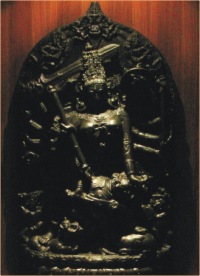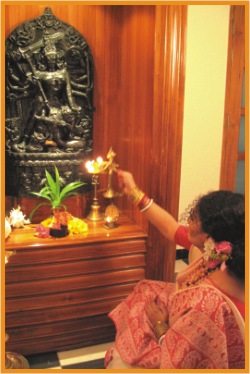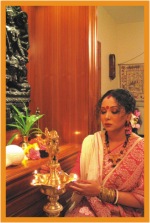 durga
puja
durga
puja
THE
sky is a clear translucent blue. The previously billowing clouds have
become wispy remnants like cigarette smoke disappearing in the air.
Monsoons torrential rains have just stopped leaving the rivers lapping
along the banks. The fields filled with reed and their willowy white
flowers float in the breeze. It happens every year in accordance with
the seasonal cycle. These signs spell out the end of monsoon and the
beginning of winter. It lasts for a very short time bringing with
it a season filled with festivities. One such festival is the Durga
Puja. It officially begins on the seventh day form the sighting of
the new moon during the Bangla month of Ashwin and continues
till the tenth day. This period signifying the arrival of the goddess
is called Mohaloya.
The
awakening
The day before the Puja sets off is known as the Devi'r Bodhon
(goddesses' awakening). It takes place at the base of a wood apple
tree and the story behind this awakening is that the gods and goddesses
have spent the monsoon period in rest and solitude. This particular
tree has been chosen as it symbolises the sun. After all, the sun
being all-powerful, befits an all powerful goddess. In another sense
the awakening of the goddess also signifies the rebirth of the spirit
in the human soul.
 Kumari
puja
Kumari
puja
Kumari Puja is a part of Durga Puja that is celebrated with equal
zest. It takes place on the eighth day where any unmarried female
within one to sixteen years is given devotion due to a goddess. The
selected girl is given a bath after which she is decked out in new
clothes, ornaments and garlands. Red alta highlights on the
feet and forehead complement the flowers on her wrist. She is then
sat on a decorated stage surrounded by the knick-knacks related to
puja. The chosen maiden is presented as the ideal woman embracing
all the good and admirable traits. She portrays a vision of the ethereal
goddess that satiates the devotees. Through the chosen maiden the
devoted get a glimpse of their idol.
History
Hindu lore has it that an demonic entity named Mohishashur managed
to drive out all the gods from their utopian abode and take over the
place. In despair they sought advice from Brahma who fell in a dilemma
as it was his blessing that prevented anyone from slaying Mohishashur.
So he went to Vishnu for help who suggested that the collective soul
of all the gods would create a feminine form that would have the power
to solve their plight. And so it was done with the gods presenting
her with all their weaponry to fight their battle.
Durga has another
story behind it where the goddess was so named for banishing a demon
named Durgam. As wicked demons go Durgam wanted to enslave the inhabitants
of the word in total despair. Durga became its destroyer.
 Durga's
armory
Durga's
armory
Durga has ten arms each clutching a different weapon including a shield,
dice, trident, discus and hatchet. Add that up with three fiery eyes
and it presents a formidable opponent. It is said that she possesses
the strength of all the gods and they are all linked to her.
Durga's
family
In our country we typically see a framework consisting of seven statues.
In the middle there is Durga with Lakhsmi and Ganesh on her right
and Saraswati and Kartik on her left. At her feet are a lion and a
demon. According to folklore the festival represents the goddess coming
home to her paternal home with her children (that's Lakhsmi, Ganesh,
Saraswati and Kartik).
Another
notable icon is the Kola Bou or NabaGottika. This
is a statue made up of nine different tree limbs tied to a banana
tree. A shawl is put on top making it look like a veiled woman and
hence the name Kola Bou (banana bride). It symbolises nine
different forms of the goddess Durga.
 Durga
is a symbol of strength and unity with all the gods and even the demon
brought together. Durga puja is a festival that brings together all
the devotees and in a way it tries to bring unity among its followers.
The statues are mainly made using clay from Rajbari. It is made malleable
with the help of water from the Ganges or from the sea. Everyone from
all classes of society are brought together for this event. In fact,
classes are merged as everyone stands together in obeisance. In unity
everyone asks for peace.
Durga
is a symbol of strength and unity with all the gods and even the demon
brought together. Durga puja is a festival that brings together all
the devotees and in a way it tries to bring unity among its followers.
The statues are mainly made using clay from Rajbari. It is made malleable
with the help of water from the Ganges or from the sea. Everyone from
all classes of society are brought together for this event. In fact,
classes are merged as everyone stands together in obeisance. In unity
everyone asks for peace.
It is not only
the devotees but also people of other religions who are touched by
this event. Many people come by to see the colourful festivities.
Hindu friends send invitations with cards and gifts being exchanged.
It has implications far deeper than the religious. As a social event
it brings people together in unity as symbolised by Durga the goddess.
By
Sultana Yasmin
Tanslated by Ehsanur Raza Ronny
Model: Moni Dipa
Makeup: Farzana Shakil
Photo: Zahedul I Khan
Special thanks to Ram Krishna Mission and their library
We thank Mrs Mira Dutta for allowing us to do the
photo shoot at her lovely house

